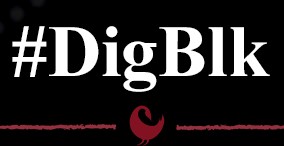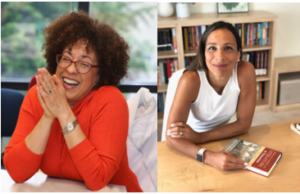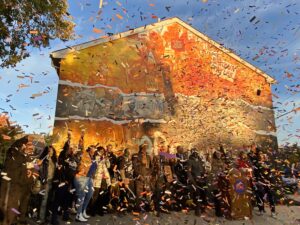Center for Black Digital Research Builds Community by Recovering History

Founded only three years ago, the Center for Black Digital Research (CBDR) at Penn State has quickly established itself as a premier institution that demonstrates the exciting potential and far-reaching impacts of public humanities scholarship. The CBDR, also known as #DigBlk, developed out of efforts by two Penn State professors of English and African American Studies, Gabrielle Foreman and Shirley Moody-Turner, to recover records of Black-led justice movements and make previously inaccessible primary source materials and organizing archives widely available to researchers, students, and the general public. Co-founded and co-directed by Foreman and Moody-Turner, the CBDR is a collaborative endeavor to recuperate the history of Black community organizing, uniting individuals and organizations not just at Penn State, but across the country.
“CBDR is definitely an expansive network,” says Yolanda Mackey, a graduate student in English and African American Studies at Penn State and current #DigBlk scholar. This network, she notes, includes “librarians and archivists and full professors and assistant professors, post-docs, graduate students at various levels, [and] undergraduates.” This diversity of disciplinary backgrounds and perspectives not only enables “collaboration, but also discussions that you wouldn’t have if you didn’t have a mixture of those folks in the room.”
A nonhierarchical approach is foundational to the CBDR. In 2012, the Colored Conventions Project (one of three flagship projects now under the #DigBlk banner, along with Douglass Day and the Black Women’s Organizing Archive) was founded in one of Foreman’s graduate classes at the University of Delaware as an outgrowth of conversations and questions posed by students. One of those students, Jim Casey, is now an assistant professor at Penn State and associate director of the CBDR—a testament to the Center’s commitment to, in Foreman and Casey’s words, “empowering graduate students to grow into important leadership roles across disciplines and communities.”

Past and present #DigBlk graduate student scholars have had tremendous success winning competitive funding opportunities, publishing their work, and securing employment both within and outside of academia. As Foreman and Casey note, though it is “a challenging time in terms of jobs,” #DigBlk alumni have found work “as professors, Center directors, and digital archives leaders” at a range of institutions, including UC Irvine, Howard University, Swarthmore College, and the University of Pennsylvania. Moreover, the Center’s work supporting the research of “undergraduate students across more than 70 majors and minors,” Foreman and Casey report, “has fueled [those students’] job and graduate student placement.”
These successes are in part attributable to the unique kind of mentorship, and novel forms of leadership, offered by the CBDR. Team meetings involve members from across the organization “thinking through ideas” side-by-side, says Mackey, “and so there’s a type of mentorship that’s happening in those settings.” Foreman and Casey emphasize the need to “advocate for [our] students and make sure their labor, time, and expertise is acknowledged and well compensated.” The Center has codified its collaborative principles and developed memoranda of understanding for its various initiatives that have been used as models by other research centers.
Courtney Murray, a graduate student in English and African American Studies at Penn State and current #DigBlk scholar, has witnessed these principles in action. After assisting Moody-Turner with the 2020 Douglass Day “transcribe-a-thon” of Anna Julia Cooper’s work and acquiring “experience from start to finish of a digital transcription project,” Murray was invited to join the then-forthcoming Center for Black Digital Research as one of its inaugural #DigBlk scholars to continue this archival and digital-humanities work.
Her subsequent work with the CBDR, which has continued to focus largely on Douglass Day, has highlighted for Murray the importance of “Black women’s organizing efforts to create but also sustain Douglass and his legacies.” Murray’s own research focuses on nineteenth-century diasporic archives and literatures, and she is “interested in how people are organizing and doing things in the nineteenth century.” Her work with the CBDR has made clear the imperative to “always center Black women’s labor, creativity, and organizing. If you don’t, you’re just missing out on a lot of what the nineteenth century was about. A lot of community self-development was being thought out through women in their roles as mothers [and] wives.”
Through its emphasis on digital humanities, adds Mackey, the CBDR provides “a fresh perspective on how to make this collective organizing that was happening during the nineteenth century” carry into the present day. She notes that the Black Women’s Organizing Archive is developing a Digitize Black Women’s Records Day as “a sister program to Douglass Day” that will aid in “preserving and digitizing Black women’s records.” Mackey emphasizes that the impacts of this work are felt far beyond academia, by “individuals in communities and families” for whom “preserving their family’s records [is] important.”
Lauren Barnes, a graduate student in English and African American Studies at Penn State and current #DigBlk scholar, notes how the Center’s work helps “to empower and affirm communities.” Recently, the CBDR’s Colored Conventions Project partnered with Mural Arts Philadelphia to produce two murals that celebrate Philadelphia’s history as a center for Black organizing. These murals, Barnes says, represent “how communities get together and work together to address issues of injustice [and] Black civil rights.”

The partnerships the CBDR forges with other organizations and publics, says Barnes, provide an “opportunity for amplifying voices within communities that have been present but not always foregrounded” in history. She continues, “These partnerships are very important ways to engage the work of community members who are interested in learning more about their own history or the history of their communities.”
Barnes, along with many other members of the CBDR, was present for the unveiling of these murals in November. “It was just a really celebratory day,” she says. “It was empowering, it was soul-feeding, and it was very much an amplification of voices who have a long history of organizing.” Through the CBDR’s inspiring and innovative work, these long (and sometimes long-forgotten) community histories are coming alive in the digital age. As Barnes says, “Bringing that lens to a public space is just so important in not only celebrating Black history, but in celebrating American history.”

Founded only three years ago, the Center for Black Digital Research (CBDR) at Penn State has quickly established itself as a premier institution that demonstrates the exciting potential and far-reaching impacts of public humanities scholarship. The CBDR, also known as #DigBlk, developed out of efforts by two Penn State professors of English and African American Studies, Gabrielle Foreman and Shirley Moody-Turner, to recover records of Black-led justice movements and make previously inaccessible primary source materials and organizing archives widely available to researchers, students, and the general public. Co-founded and co-directed by Foreman and Moody-Turner, the CBDR is a collaborative endeavor to recuperate the history of Black community organizing, uniting individuals and organizations not just at Penn State, but across the country.
“CBDR is definitely an expansive network,” says Yolanda Mackey, a graduate student in English and African American Studies at Penn State and current #DigBlk scholar. This network, she notes, includes “librarians and archivists and full professors and assistant professors, post-docs, graduate students at various levels, [and] undergraduates.” This diversity of disciplinary backgrounds and perspectives not only enables “collaboration, but also discussions that you wouldn’t have if you didn’t have a mixture of those folks in the room.”
A nonhierarchical approach is foundational to the CBDR. In 2012, the Colored Conventions Project (one of three flagship projects now under the #DigBlk banner, along with Douglass Day and the Black Women’s Organizing Archive) was founded in one of Foreman’s graduate classes at the University of Delaware as an outgrowth of conversations and questions posed by students. One of those students, Jim Casey, is now an assistant professor at Penn State and associate director of the CBDR—a testament to the Center’s commitment to, in Foreman and Casey’s words, “empowering graduate students to grow into important leadership roles across disciplines and communities.”

Past and present #DigBlk graduate student scholars have had tremendous success winning competitive funding opportunities, publishing their work, and securing employment both within and outside of academia. As Foreman and Casey note, though it is “a challenging time in terms of jobs,” #DigBlk alumni have found work “as professors, Center directors, and digital archives leaders” at a range of institutions, including UC Irvine, Howard University, Swarthmore College, and the University of Pennsylvania. Moreover, the Center’s work supporting the research of “undergraduate students across more than 70 majors and minors,” Foreman and Casey report, “has fueled [those students’] job and graduate student placement.”
These successes are in part attributable to the unique kind of mentorship, and novel forms of leadership, offered by the CBDR. Team meetings involve members from across the organization “thinking through ideas” side-by-side, says Mackey, “and so there’s a type of mentorship that’s happening in those settings.” Foreman and Casey emphasize the need to “advocate for [our] students and make sure their labor, time, and expertise is acknowledged and well compensated.” The Center has codified its collaborative principles and developed memoranda of understanding for its various initiatives that have been used as models by other research centers.
Courtney Murray, a graduate student in English and African American Studies at Penn State and current #DigBlk scholar, has witnessed these principles in action. After assisting Moody-Turner with the 2020 Douglass Day “transcribe-a-thon” of Anna Julia Cooper’s work and acquiring “experience from start to finish of a digital transcription project,” Murray was invited to join the then-forthcoming Center for Black Digital Research as one of its inaugural #DigBlk scholars to continue this archival and digital-humanities work.
Her subsequent work with the CBDR, which has continued to focus largely on Douglass Day, has highlighted for Murray the importance of “Black women’s organizing efforts to create but also sustain Douglass and his legacies.” Murray’s own research focuses on nineteenth-century diasporic archives and literatures, and she is “interested in how people are organizing and doing things in the nineteenth century.” Her work with the CBDR has made clear the imperative to “always center Black women’s labor, creativity, and organizing. If you don’t, you’re just missing out on a lot of what the nineteenth century was about. A lot of community self-development was being thought out through women in their roles as mothers [and] wives.”
Through its emphasis on digital humanities, adds Mackey, the CBDR provides “a fresh perspective on how to make this collective organizing that was happening during the nineteenth century” carry into the present day. She notes that the Black Women’s Organizing Archive is developing a Digitize Black Women’s Records Day as “a sister program to Douglass Day” that will aid in “preserving and digitizing Black women’s records.” Mackey emphasizes that the impacts of this work are felt far beyond academia, by “individuals in communities and families” for whom “preserving their family’s records [is] important.”
Lauren Barnes, a graduate student in English and African American Studies at Penn State and current #DigBlk scholar, notes how the Center’s work helps “to empower and affirm communities.” Recently, the CBDR’s Colored Conventions Project partnered with Mural Arts Philadelphia to produce two murals that celebrate Philadelphia’s history as a center for Black organizing. These murals, Barnes says, represent “how communities get together and work together to address issues of injustice [and] Black civil rights.”

The partnerships the CBDR forges with other organizations and publics, says Barnes, provide an “opportunity for amplifying voices within communities that have been present but not always foregrounded” in history. She continues, “These partnerships are very important ways to engage the work of community members who are interested in learning more about their own history or the history of their communities.”
Barnes, along with many other members of the CBDR, was present for the unveiling of these murals in November. “It was just a really celebratory day,” she says. “It was empowering, it was soul-feeding, and it was very much an amplification of voices who have a long history of organizing.” Through the CBDR’s inspiring and innovative work, these long (and sometimes long-forgotten) community histories are coming alive in the digital age. As Barnes says, “Bringing that lens to a public space is just so important in not only celebrating Black history, but in celebrating American history.”